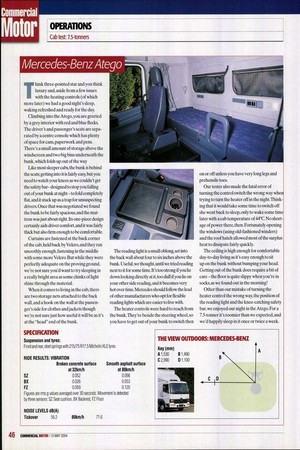Mercedes-Benz Atego
Page 46

If you've noticed an error in this article please click here to report it so we can fix it.
Think three-pointed star and you think luxury and, aside from a few issues with the heating controls (of which more later) we had a good night's sleep, waking refreshed and ready for the day. Climbing into the Atego, you are greeted by a grey interior with red and blue flecks. The driver's and passenger's seats are separated by a centre console which has plenty of space for cans, paperwork and pens. There's a small amount of storage above the windscreen and two big bins underneath the bunk, which folds up out of the way
Like most sleeper cabs, the bunk is behind the seats; getting into it is fairly easy,but you need to watch your knees as we couldn't get the safety bar— designed to stop you falling out of your bunk at night—to fold completely flat, and it stuck up as a trap for unsuspecting drivers. Once that was negotiated we found the bunk to be fairly spacious, and the mattress was just about right. Its one-piece design certainly aids driver comfort, and it was fairly thick but also firm enough to be comfortable.
Curtains are fastened at the back corner of the cab, held back by Velcro, and they run smoothly enough, fastening in the middle with some more Velcro. But while they were perfectly adequate on the proving ground, we're not sure you'd want to try sleeping in a really bright area as some chinks of light shine through the material.
When it comes to living in the cab, there are two storage nets attached to the back wall, and a hook on the wall at the passenger's side for clothes and jackets though we're not sure just how useful it will be as it's at the "head" end of the bunk.
The reading light is a small oblong, set into the back wall about four to six inches above the bunk. Useful, we thought, until we tried reading next to it for some time. It's too strong if you lie down looking directly at it, too dull if you lie on your other side reading, and it becomes very hot over time. Mercedes should follow the lead of other manufacturers who opt for flexible reading lights which are easier to live with. The heater controls were hard to reach from the bunk. They're beside the steering wheel, so you have to get out of your bunk to switch then
on or off unless you have very long legs and prehensile toes.
Our tester also made the fatal error of turning the control switch the wrong way whe trying to turn the heater off in the night.Thinking that it would take some time to switch off she went back to sleep, only to wake some time later with a cab temperature of 44°C. No shortage of power there, then. Fortunately opening the windows (using old-fashioned winders) and the roof hatch allowed most of the surplus heat to dissipate fairly quickly.
The ceiling is high enough for comfortable day-to-day living as it's easy enough to sit up on the bunk without bumping your head. Getting out of the bunk does require a bit of care —the floor is quite slippy when you're in socks, as we found out in the morning!
Other than our mistake of turning the heater control the wrong way, the position of the reading light and the knee-catching safety bar, we enjoyed our night in the Atego. For a 7.5-tonner it's roomier than we expected, and we'd happily sleep in it once or twice a week.




















































































































































































































